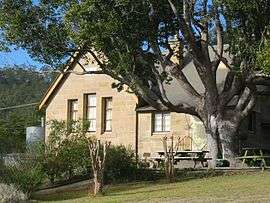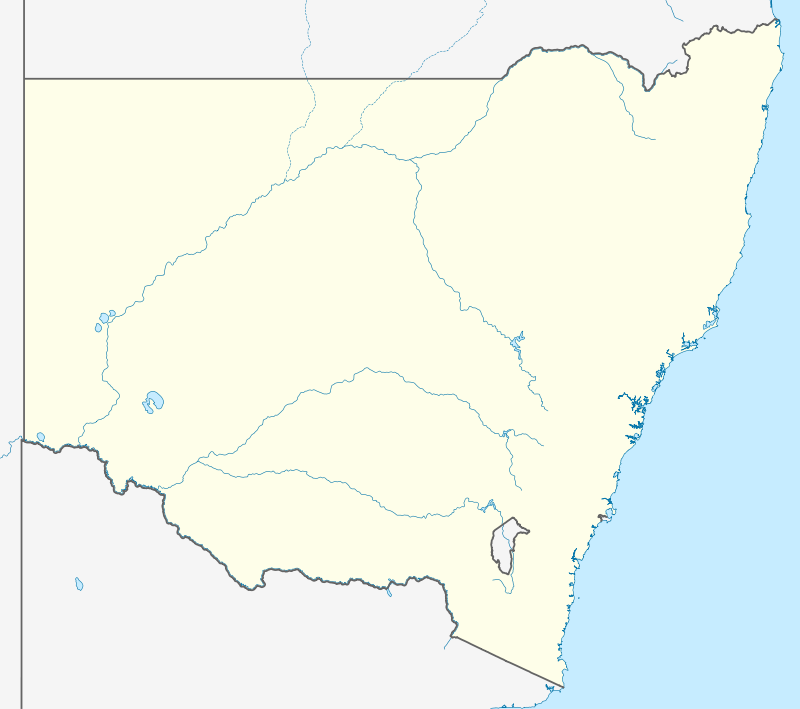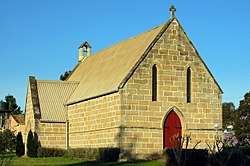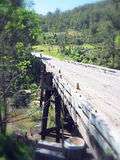Wollombi, New South Wales
Wollombi (/wɒlʌmˈbaɪ/ wo-lum-BYE) is a small village in the Hunter Region of New South Wales, Australia. It is within the Cessnock City Council LGA, situated 29 kilometres (18 mi) southwest of Cessnock and 128 km (80 mi) north of Sydney. To the south is the village of Laguna, to the east, the village of Millfield and to the north, the village of Broke.
| Wollombi Cessnock, New South Wales | |||||||||
|---|---|---|---|---|---|---|---|---|---|
 Wollombi Public School | |||||||||
 Wollombi | |||||||||
| Coordinates | 32°55′54″S 151°08′04″E | ||||||||
| Population | 264 (2006 census)[1] | ||||||||
| Postcode(s) | 2325 | ||||||||
| Elevation | 80 m (262 ft) | ||||||||
| Time zone | AEST (UTC+10) | ||||||||
| • Summer (DST) | AEDT (UTC+11) | ||||||||
| Location | |||||||||
| LGA(s) | Cessnock City Council[2] | ||||||||
| Region | Hunter[2] | ||||||||
| County | Northumberland[3] | ||||||||
| Parish | Corrabare[3] | ||||||||
| State electorate(s) | Cessnock[4] | ||||||||
| Federal Division(s) | Hunter[5] | ||||||||
| |||||||||
The valley is bordered to the west by the World Heritage listed Yengo National Park (and Yengo State Forest) and the main road, the convict-built Great North Road (GNR) forms one of the major legs of the Greater Blue Mountains Drive. To the east lie Watagans National Park along with Corrabare and Olney State Forests.
Wollombi's modest modern size is offset by its 19th-century sandstone buildings and timber slab constructed cottages and sheds in a narrow valley junction containing Wollombi Brook and Congewai Creek. Narone and Yango Creeks also join these waterways near the village.
The area is home to an abundance of native birds, reptiles and other animals including kangaroos, wallabies, wallaroos and wombats and is surrounded by imposing tree-lined mountains.
History
Indigenous history
The traditional custodians of the locality are believed to be the Darkinjung people, though the Awabakal and Wonnarua nations are also mentioned.
The town's name is an Aboriginal term said to mean 'meeting place of the waters' or simply 'meeting place' ("Derived from Awabakal Aboriginal term for 'meeting of waters', but this cannot be linguistically verified. (Appleton; 1992). Also: meeting of the waters. (McCarthy; 1963)."[3]). It was apparently pronounced 'Wu-lum-bee', though today it is pronounced Wo (as in wok) - lum (as in thumb) - bi (as in buy).
There is a vast number of historic Aboriginal sites in the surrounding countryside which is thought to have been used as a ceremonial meeting place as people from hundreds of kilometres visited the area and made their way to Mount Yengo - a place of great significance throughout the ancient nations of eastern Australia.
There are rock engravings, sharpening grooves, hand stencils, tribal markings and other images in caves and outcrops, frequent evidence of camping sites along the Brook and its tributary creeks, and two major mapping sites containing many engravings.
European history
The establishment, development and significance of the township of Wollombi was directly connected with the construction and importance of the Great Northern Road in the early 19th century. The Howes Valley Rd (Putty Road) was completed in 1823, but travel along it was thought to be too difficult to be a success commercially.
Major Thomas Mitchell - Surveyor-General - formulated the idea of an inland route to open up transport to regions in northern NSW. Heneage Finch, who later settled in Laguna, surveyed the route for the Great Northern Road via Castle Hill, Wisemans Ferry, St Albans, Laguna and Wollombi.
At Wollombi, the road diverged toward Singleton and Muswellbrook to the north, and Cessnock and Maitland to the north east.
Hundreds of convicts began building the road from Castle Hill to Wollombi. One group was headquartered at Castle Hill where over 380 men were organised in seven road parties. They began work on the section of road south of the Hawkesbury. A second group, of 119 men, worked from Newcastle in two road parties, one between Newcastle and Wallis Plains (Maitland) and the other between Wallis Plains and Wollombi.[6]
Road construction commenced in 1826 and was completed in 1831. Remnants such as stone culverts, bridges and retaining walls remain, particularly in the area between Wisemans Ferry and Wollombi, and are catalogued and cared for by The Convict Trail Project.
During the years before the GNR was commenced, only a few large land grants (1,000–2,000 acres (405–809 ha)) were allocated along Cockfighter's Creek or the lower Wollombi Brook, to John Blaxland and - Rodd at Fordwich, Heneage Finch at Laguna and Thomas Crawford at Congewai. Richard Wiseman received 640 acres (259 ha) near Wollombi. After 1830 the holdings in the Wollombi Valley were about 100 acres (40 ha).[6]
Surveyor GB White surveyed the village reserve at Wollombi into sections and allotments in 1833.[6]
A horseman who travelled from Sydney to Patrick's Plains in 1827 along the line of road in progress took three days for the journey – the first day to Wiseman's Ferry - 49 miles (79 km). The second day to 'the head of the Wollombi' (about 12 mi (19 km) south of the future Wollombi village reserve) - 40 mi (64 km), and the third day to Patrick's Plains - 36 mi (58 km), made a total of 125 mi (201 km).[6]
The settlement developed as a centre for the farming community and for travellers on the Great North Road. Then, on 12 June 1831, the steamship 'Sophie Jane' sailed from Sydney to the port of Morpeth on the Hunter River in eleven and a half hours. With the speed and carrying capacity of the ship far surpassing that of road transport to the Hunter region, the commercial significance of the Great Northern Road immediately diminished.
By the early 1840s, the inns operating at intervals along the Great North Road and its branch toward Maitland were (Solomon) Wiseman's at the Ferry, (Richard) Wiseman's Inn at the head of the Wollombi Valley (from 1827), Traveller's Test at Laguna (1835), Governor Gipps at Wollombi (1840), Rising Sun at Millfield (1840s) and the Cock Inn on Cockfighter Creek (c1840s).[6]
The foundation stone of Saint Michael's Catholic Church was laid near the Congewai Creek crossing (Cunneens Bridge) in 1840 but the church was moved to its present location following severe damage in the 1893 flood. St John's Anglican Church was built in 1846. The Wollombi Telegraph Office opened in 1860, the former Police station and Courthouse (now Endeavour Museum) was built c1866, the stone School building c1881 (the original school opened in 1852[7]) and the timber General Store is well over a century old.
By 1850 the village had an Anglican and Catholic Church, a flour mill, a village cemetery and its own District Council. By 1851 the population was recorded as 105. By 1862 there were 1655 people living in the district with 233 in the village itself[7] and by 1867 there were 1800 people in the area.
The 1860s were the years of greatest development. The production figures for 1867 were 26,856 bushels of wheat, 23,042 bushels of maize, 398 of barley, 680 of oats, 88 tons of potatoes, 7,502 lbs of tobacco and 180 gallons of wine. The livestock numbers in the valley were as follows: 5,853 head of cattle, 3,543 sheep and 1,449 pigs.[8]
Rust devastated the area in the 1870s causing wheat crop failures. This undermined the economic base of the region and along with overfarming of the land causing a loss of productivity and severe floods removing topsoil, the district entered a period of decline which continues to the present time.[7]
By 1911 the population of the village had reached a high of 406 but it had declined to 151 in 1961.[9] In the 2006 census, the population of Wollombi was 264, consisting of 136 male and 128 female residents.[1]
Wollombi Public School was closed at the end of 2014 despite a long-running campaign by parents to keep the school operating.[10]
Heritage listings
Wollombi has a number of heritage-listed sites, including:
Gallery

 Cunneens Bridge
Cunneens Bridge Saint Michael's Church
Saint Michael's Church Mulla Villa
Mulla Villa Wollombi Cattle Sales
Wollombi Cattle Sales- Wollombi Sale Yards
 Wollombi Endeavour Museum (formerly Courthouse) at night
Wollombi Endeavour Museum (formerly Courthouse) at night Lace Monitor (Goanna) - Varanus varius
Lace Monitor (Goanna) - Varanus varius Wallaroo joey
Wallaroo joey Kookaburra - Dacelo novaeguineae
Kookaburra - Dacelo novaeguineae
Footnotes
- Australian Bureau of Statistics (25 October 2007). "Wollombi (State Suburb)". 2006 Census QuickStats. Retrieved 8 April 2009. Map
- "Suburb Search - Local Council Boundaries - Hunter (HT) - Cessnock City Council". New South Wales Division of Local Government. Retrieved 8 April 2009.
- "Wollombi". Geographical Names Register (GNR) of NSW. Geographical Names Board of New South Wales. Retrieved 8 April 2009.

- "Cessnock". New South Wales Electoral Commission. 28 March 2015. Retrieved 23 November 2019.
- "Hunter". Australian Electoral Commission. 19 October 2007. Retrieved 8 April 2009.
- Cunneen's Bridge Conservation Assessment By Bill Jordan and Associates Pty Ltd (1.75MB pdf file)
- Schools of the Wollombi Valley A brief History - Wollombi and Laguna Parents and Citizens Associations October 1981 (Reprinted July 1990) pp. 1-9
- Elkin A. P. The Wollombi and the Parish of Wollombi. Courtney, Cessnock 1946
- Wollombi - Sydney Morning Herald (Online - Retrieved on 2009-04-07) - 8 February 2004
- Parents lose fight to keep Wollombi Public School open ABC News (Online - Retrieved on 2016-08-02) - 12 Nov 2014
- "Great North Road, Between Mt Manning and Wollombi". New South Wales State Heritage Register. Office of Environment and Heritage. H01789. Retrieved 18 May 2018.
- "St John The Evangelist Anglican Church". New South Wales Heritage Database. Office of Environment and Heritage. Retrieved 30 September 2017.
References
- Wollombi Valley Online - Wollombi History (Used with permission)
- Explore the Convict Trail: Great North Road - ISBN 0-9585697-5-4
- D Mahony and J Whitehead, eds, The Way of the River Environmental Perspectives on the Wollombi, Wollombi Valley Landcare Group - University of Newcastle Department of Community Programmes 1994
External links
| Wikimedia Commons has media related to Wollombi, New South Wales. |
- "Hunter River catchment" (map). Office of Environment and Heritage. Government of New South Wales.
- Wollombi Valley Community Website
- Greater Blue Mountains Area at UNESCO World Heritage Centre
- Blue Mountains World Heritage Institute
- Wollombi Valley Arts Council